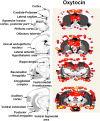Functional magnetic resonance imaging shows oxytocin activates brain regions associated with mother-pup bonding during suckling
- PMID: 16354922
- PMCID: PMC6726012
- DOI: 10.1523/JNEUROSCI.3604-05.2005
Functional magnetic resonance imaging shows oxytocin activates brain regions associated with mother-pup bonding during suckling
Abstract
Oxytocin is released in the maternal brain during breastfeeding and may help strengthen the mother-infant relationship. Here, we used functional magnetic resonance imaging to determine whether oxytocin modulates brain activity in postpartum day 4-8 dams receiving suckling stimulation. During imaging sessions, dams were exposed to pup suckling before and after administration of an oxytocin receptor antagonist. Another group of dams received oxytocin alone. Changes in brain activation in response to suckling closely matched that elicited by oxytocin administration. The overlapping brain areas included the olfactory system, nucleus accumbens, insular cortex, prefrontal cortex, ventral tegmental area, cortical amygdala, and several cortical and hypothalamic nuclei. Blockade of oxytocin receptors largely attenuated activation in these regions. The data suggest that oxytocin may strengthen mother-infant bond formation partly by acting through brain areas involved in regulating olfactory discrimination, emotions, and reward.
Figures






References
-
- Byrnes EM, Rigero BA, Bridges RS (2002) Dopamine antagonists during parturition disrupt maternal care and the retention of maternal behavior in rats. Pharmacol Biochem Behav 73: 869–875. - PubMed
-
- Fleming A, Vaccarino F, Tambosso L, Chee P (1979) Vomeronasal and olfactory system modulation of maternal behavior in the rat. Science 203: 372–374. - PubMed
Publication types
MeSH terms
Substances
Grants and funding
LinkOut - more resources
Full Text Sources
Medical
